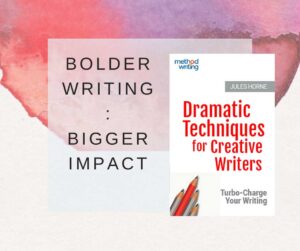One especially rewarding aspect of the Open University MA course in Creative Writing is the chance to make a sideways swerve into another writing form. So, for example, poets can try their hands at fiction for a term, and non-fiction writers discover the different rhythms and possibilities of scriptwriting.
As a fiction writer turned playwright who’s also had a go at song lyrics, this cross-genre exploration is dear to my heart. Each writing world has its own concepts, and I’ve learned so much from each.
In particular, dramatic techniques from live drama have transformed my relationship with writing and editing. Concepts such as beats, reversals, ritual, status and transformation; thinkers like Stanislavski, Goffman, Berne and Bachelard have so much to offer fiction writers, especially when it comes to shape and deep structure. After years of evangelising about the powerful concepts of drama to writers of all persuasions, I decided to compile them into a book.
 Dramatic Techniques for Creative Writers covers the ground I wish I’d known about when starting out as a playwright. It’s an eclectic mix of techniques to power up your writing and make your storytelling bolder, more engaging, and more compelling.
Dramatic Techniques for Creative Writers covers the ground I wish I’d known about when starting out as a playwright. It’s an eclectic mix of techniques to power up your writing and make your storytelling bolder, more engaging, and more compelling.
Why are dramatic techniques so powerful? Because they’ve been test-driven for centuries in front of unforgiving live audiences. They’ve passed many other filters, too, before a word you’ve written reaches an audience – actors, director, producer and your own experience of living, breathing language in the amplifying echo chamber of the rehearsal room. So as a playwright, you undergo (in some case, endure!) full-on, experiential, fast-track learning about flow, rhythm, engagement, and so much else.
Here are a few of the dramatic storytelling tools I’ve drawn on in my fiction:
Spatial thinking
How do you establish your written world? Is it inside or outside your narrator’s head, or somewhere between? What broad brush-strokes are needed to make the context clear?
Transformations and reversals
In a story, something changes. On stage, that change is made visible. From… to… creates a strong narrative shape. How can you use transformation to create a bold story?
Powerful images
The central images in some of Shakespeare’s plays – Juliet / balcony, Hamlet/ skull, Bottom/ ass’s head – are so clear and simple that they translate into any culture, yet resonate with great complexity. Is your core visual image just as clear?
Performance as metaphor
Erving Goffman’s work shows how an audience makes people behave differently, responding to status, complex social roles, forming tribes, and so on. How can this be used to add layers and tension to your writing?
Dramatic actions
Characters with burning desires that are thwarted create knotty emotional complexity and strong stories. How can you use Stanislavski’s ideas on impulses and motivation to give your characters momentum?
Aside: it’s true that not all fiction writers need or want to use these techniques. Fiction can live in different and subtle spaces of the mind, and has its own concepts and creative vocabulary. But dramatic techniques read at a distance, and I find them a great help with bold writing decisions, especially when structuring a scene or mapping a story.
Jules Horne teaches on A363 and the Open University MA course and lives in Scotland.
www.juleshorne.com
